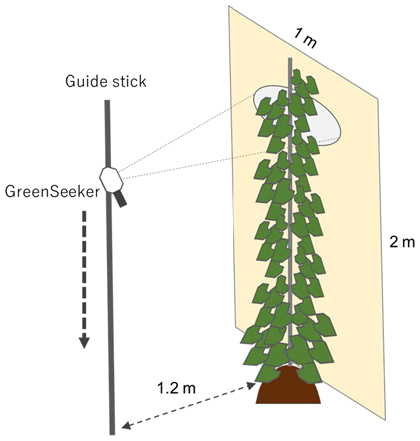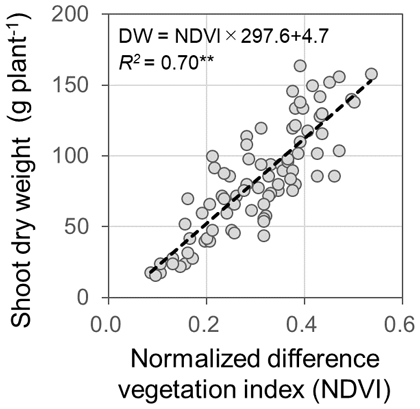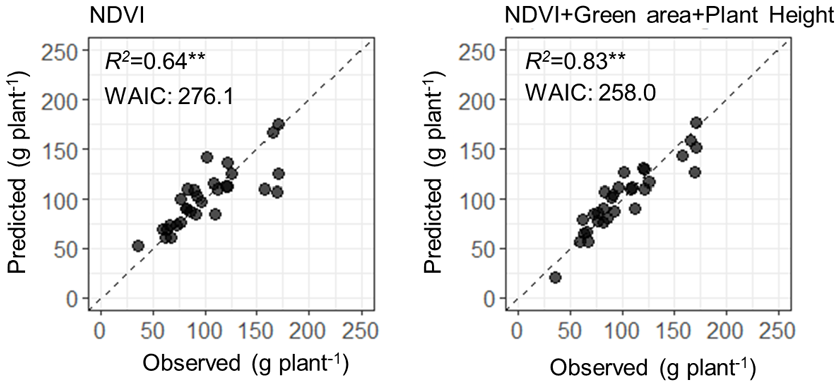Non-destructive shoot biomass evaluation for field-grown staking yam (Dioscorea rotundata Poir)
Description
Yam is a minor but important tuber crop grown widely in temperate to tropical regions. The total yam-cultivated area is 7.5 million hectares, with an annual harvest of 65.9 million tons of tubers. West Africa is the largest yam-cultivating area, accounting for more than 94% of the world’s yam production, with Dioscorea rotundata being the major species used for local consumption. However, the development of varieties in this region has not benefitted from modern breeding. One reason for this slow breeding progress is the lack of phenotypic information on genetic resources due to the long growth period, low planting density, and method of reproduction (i.e., by vegetative propagation) require space, time, and effort for cultivation), thereby restricting the number of genetic resources in previous growth studies.
In this study, we developed a non-destructive method to predict shoot biomass by measuring spectral reflectance in staking yam. The normalized difference vegetation index (NDVI) was evaluated using a handheld sensor (GreenSeeker, Nikon Trimble, Tokyo, Japan) to vertically scan the plant from top to bottom along the length of the stake (Fig. 1). The scanning was carefully performed for 30 s per measurement, keeping the scan speed constant from top to bottom. To eliminate the background noise of the reflectance, a 1 m × 2 m board was placed behind the plant. A linear regression model was constructed to predict shoot biomass using NDVI as a parameter (NDVI×297.6+4.7). The observed values of shoot biomass, irrespective of the genotypes, were predicted well by the model (Fig. 2). Conversely, the model tended to underestimate the shoot biomass when the actual shoot biomass exceeded 150 g plant-1; this was compensated for when the parameters of green area, calculated from plant image and plant height, were included in the model (NDVI×120.9+205.9×Green area-38.4×Plant height+40.0) (Fig. 3).
This method reduced the time, cost, effort, and field space needed for shoot biomass evaluation compared with that needed for the sampling method. The information on shoot biomass is widely available for growth analysis and for the evaluation of stress tolerance and crop models. In addition, the rapid phenotyping method fulfills the phenotypic information demands of a large number of genetic resources and cross populations. In combination with genetic tools, shoot biomass evaluation using NDVI will serve as a key method for accelerating yam breeding programs, as shown in major crops. In addition, good relationships between final tuber yield and the value of NDVI at middle growth stage were observed, indicating that this method can also be used for early prediction of tuber yield. However, the predictions were not stable among years with different meteorological conditions. Further studies are needed to clarify the relationship between tuber yield and NDVI.
Figure, table
-
Fig. 1. NDVI measurement procedure for staking yam.
The plant height was measured visually using the scale printed on the board behind the plant. -
Fig. 2. Correlation between NDVI and observed shoot biomass.
Model validation data of 30 yam accessions with 3 plant replications (n=90) were used. ** represents statistically significant at p = 0.01 level. -
Fig. 3. Improvement of the model prediction using additional parameters of green area and plant height.
Data of shoot biomass of the plants from different seed tuber size of same accession were used. Model performance was measured with the widely applicable information criterion (WAIC), where the smaller value represents better fitting. ** represents statistically significant at p = 0.01 level.
- Affiliation
-
Japan International Research Center for Agricultural Sciences Biological Resources and Post-harvest Division
- Research project
- Program name
- Term of research
-
FY 2018(FY2016-FY2020)
- Responsible researcher
-
Iseki Kohtaro ( Biological Resources and Post-harvest Division )
Matsumoto Ryo ( International Institute of Tropical Agriculture )
ORCID ID0000-0002-0106-6728 - ほか
- Publication, etc.
-
https://doi.org/10.1080/1343943X.2018.1540278
Iseki K and Matsumoto R (2018) Plant Prod Sci
- Japanese PDF
-
A4449.89 KB
A3248.19 KB
- English PDF
-
A4223.62 KB
A3239.83 KB
- Poster PDF
-
2018_B01_poster.pdf550.37 KB



